Global Movement of Cruising Boats
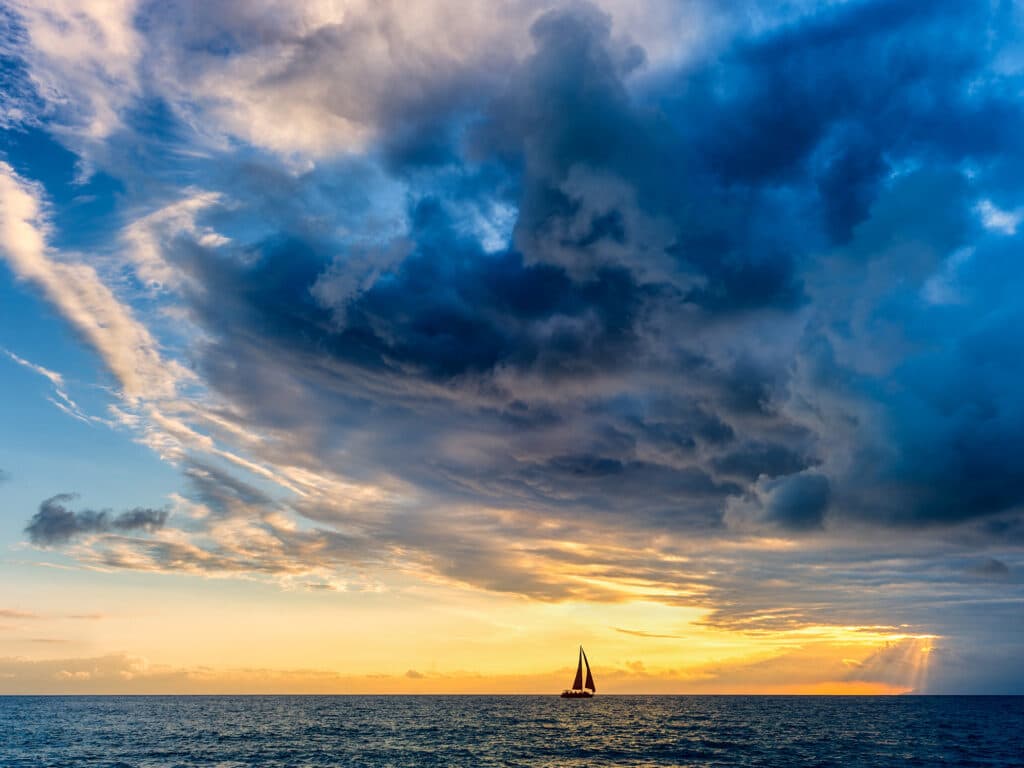 Clouds loom as a storm approaches a sailboat making an offshore passage.
mexitographer/stock.adobe.com
Clouds loom as a storm approaches a sailboat making an offshore passage.
mexitographer/stock.adobe.com
My interest in the global movement of cruising boats goes back to 1987, when I published the results of my first survey on this subject. I have since conducted follow-up surveys every five years. The latest was done in 2016. During this time, the world experienced two major phenomena that seriously affected offshore cruising: the (hopefully short-term) Covid-19 pandemic, and the longer-term climate crisis, whose consequences are expected to get worse.
The pandemic had an immediate impact on the international cruising community and caused havoc among sailors on long voyages. As many popular cruising destinations closed their borders, sailors had to postpone their plans or leave their boats unattended and return home. Those who were allowed to stay had to remain at anchor. There were several reported cases of hostile, unsympathetic attitudes from authorities and local people, even in areas where visiting sailors were previously welcomed.
In several cases, the planned voyages were abandoned. International cruising traffic came to a standstill, and my own plans for a follow-up survey in 2022 looked like they would suffer the same fate. Even if I managed to get figures from places that had supplied data in the past, in most cases, the figures would be meaningless.
To get at least a rough idea of the real situation, in early 2022, I contacted some of the most-frequented hubs on the world cruising circuit, such as Panama, Bermuda, Las Palmas de Gran Canaria, Tahiti and Noumea (in New Caledonia, South Pacific). The figures I obtained showed that while some places had fared better, others had seen an unprecedented reduction in the number of visiting boats.
Las Palmas, in the Canary Islands, recorded its highest ever influx in 2021, with 1,256 visiting boats. As the starting point for the annual ARC trans-Atlantic rally, as well as being an important transit hub, this location proved its lasting popularity thanks to the tolerant attitude of the local authorities. A similar situation was experienced in the port of Horta in the Azores, a favorite landfall at the end of a trans-Atlantic passage from the Caribbean. Horta Marina recorded 1,102 arrivals in 2021, compared to 465 in 2020 and 1,132 in 2019.
But the figures from these traditional Atlantic hubs were not indicative of the situation in other parts of the world. Panama Canal transits of pleasure craft decreased in 2021 to just 806, down from 1,122 in 2020. The drop-off was even more drastic in countries where pandemic restrictions continued into 2021, such as Tonga, New Caledonia, New Zealand and Australia—all of which recorded no arrivals. In Tahiti and South Africa, like at the Panama Canal, numbers were considerably lower than in previous years.
During 2022, as the pandemic appeared to be under control, most countries lifted their temporary restrictions. I resumed my survey by contacting officials in the most significant cruising hubs or transit points in every ocean. I requested the number of foreign-flagged yachts that had passed through those ports in 2022.
These figures let me construct a picture of the current movement of cruising yachts.
Atlantic OceanThe port of Las Palmas in the Canary Islands has a larger concentration of boats preparing for ocean passages than any other place in the world, with the majority of sailors setting off toward the Caribbean. The port authority recorded a total of 1,237 visiting boats in 2022, flying the flags of 44 countries. The largest contingent was from France (266), followed by Germany (194), the United Kingdom (83), the Netherlands (49), Sweden (42), Switzerland (38), Denmark (27), Norway (24), the United States (19), Belgium (17), Poland (16), Finland (14), New Zealand (13), Spain (12), Australia (11), Italy (9), Russia (8), Czechia (7) and smaller numbers from other countries.
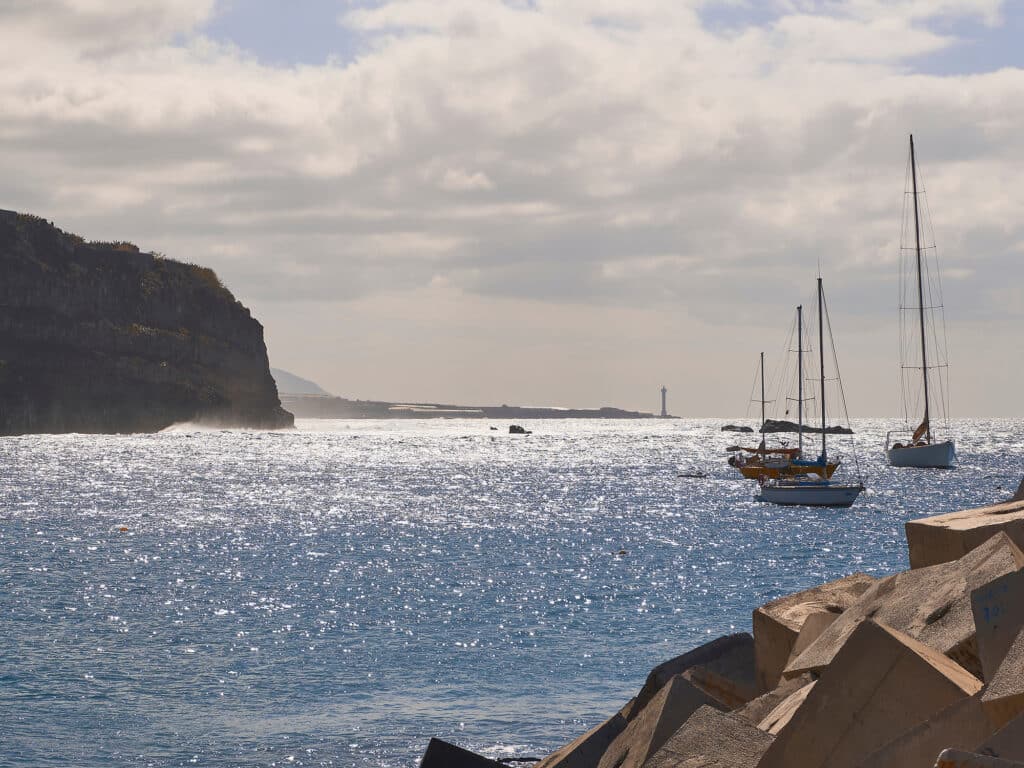 Las Palmas is a popular destination for cruising boats crossing the Atlantic Ocean. It serves as a significant stopover point for sailors participating in events like the ARC (Atlantic Rally for Cruisers), which typically sees hundreds of sailing yachts departing from Las Palmas en route to the Caribbean each year.
Basaltblick/stock.adobe.com
Las Palmas is a popular destination for cruising boats crossing the Atlantic Ocean. It serves as a significant stopover point for sailors participating in events like the ARC (Atlantic Rally for Cruisers), which typically sees hundreds of sailing yachts departing from Las Palmas en route to the Caribbean each year.
Basaltblick/stock.adobe.com
Approximately 75 percent of the boats that called at Las Palmas were bound for the Caribbean, either directly or via the Cape Verdes. An increasingly popular intermediate point for a trans-Atlantic passage is Mindelo Marina on São Vicente Island; it recorded a total of 1,120 arrivals in 2022. Located in the northeast trade wind belt, this is now considered to be a better starting point for an Atlantic passage to the Caribbean than the direct route from the Canaries, as the chance of consistent favorable winds is higher, and the distance is shorter.
Most of the European boats that sail to the Caribbean cross the Atlantic after the middle of November or early December, and complete their Atlantic circuit by sailing to the Azores the following April or May. Horta, on the island of Faial, Portugal, continues to be the preferred landfall at the end of an eastbound trans-Atlantic passage. Horta Marina has been keeping detailed records of visiting boats since 1985, and the latest data made it possible to extract a raft of interesting facts about the boats, their crews and their routes sailed.
While the total number of boats (1,131) that cleared into Horta during 2022 has not changed significantly, the data confirmed that the majority of boats on passage from the Caribbean to Europe now sail directly to the Azores, rather than via a detour to Bermuda. While Horta has overtaken Bermuda in overall number of visiting yachts, Bermuda continues to be an important transit point for North American boats sailing between the mainland and the Caribbean or Europe, as well as for boats returning from the Caribbean to the United States or Canada.
The number of boats that called at Bermuda in 2022 was 838, confirming a steady decline since 2000. This drop-off is mainly due to the large number of American boats that bypass Bermuda and sail directly to the Eastern Caribbean. The situation is reversed in May, when more boats returning to the US mainland call at Bermuda.
More than half the boats that arrive in the Caribbean from Europe or America used to spend at least one full season in the islands, but in recent years, concerns about climate change creating bigger storms have led more sailors to limit themselves to a one-year circuit, be it from Europe or North America. Those who stay longer in the Caribbean usually have their boats stored on land in a secure place during the hurricane season.
The island of Trinidad has set up several boatyards for this purpose, with 478 boats spending the summer there in 2022—a significant reduction from 2,664 in 2000 and 1,367 in 2010. According to Donald Stollmeyer, former president of the Yacht Services Association of Trinidad and Tobago, ‘The explanation is the gradual decline in the number of sailors who are prepared to keep their boats in the tropics during the hurricane season.” An even more significant reason is the fact that many insurance companies will no longer cover boats during the critical season in the tropics.
Overall, the total number of boats that spend the winter season cruising in the Caribbean has remained relatively stable in recent years. Cuba was expected to see an increase, with hopes that US restrictions on American boats would be lifted, but this has not happened. Even so, Cuba’s eight marinas recorded a total of 284 foreign-flagged yachts in 2022. According to Commodore José Miguel Diaz Escrich of the Hemingway International Yacht Club of Cuba, “We are always happy to welcome and offer our friendship to all those who love the sea.”
A good distance from Cuba, cold-water cruising is becoming more popular as sailors strike out for more challenging destinations. Two high-latitude destinations in the North Atlantic that cruising yachts regularly visit are Spitsbergen, Norway, and Greenland. The former has become the most popular high-latitude destination in the Atlantic, with 52 visiting boats recorded in 2022. Greenland is poised to become more frequented—as an attractive cruising destination in its own right, and as a base for Northwest Passage preparations. In 2022, 14 yachts called at Nuuk, the capital of Greenland, with most of them limiting their cruising to the spectacular west coast. The more intrepid sailors struck out west to brave the Northwest Passage, which has become more accessible in recent years as a result of climate change and ice melt. Four boats completed a westbound transit to the Pacific, while another four boats made a successful eastbound transit. The total of eight successful transits in 2022 compared to zero in 2021 and only one in 2020.
This newfound success may not last, though, with concerns about pollution from additional cargo and cruise ships, and the impact of cruise-ship passengers on local communities. Small boats may also be affected, as in recent years, there have been a few cases when the authorities have had to assist sailors. All those factors may result in restrictions being imposed on any vessel planning to use this waterway.
Such restrictions are already imposed at the other extreme of the Atlantic Ocean, where voyages to Antarctica on private yachts are only possible with permission from the national authorities, and the boats must abide by strict environmental protocols. The Argentinian port of Ushuaia, at the tip of South America, is where boats planning to sail south to Antarctica or north to the Chilean canals prepare and provision. The 38 arrivals in 2022 were down from 64 in 2015, and down from the peak figure of 105 in 2000.
Across the Beagle Channel from Ushuaia is Puerto Williams, a Chilean military outpost and the southernmost settlement in the world. The small port is only a short distance from Cape Horn. The Chilean authorities have jurisdiction over the Antarctic Peninsula and parts of Tierra del Fuego, so any boat planning to sail that way must complete formalities here. The movements of all vessels are monitored by the Chilean Navy, which reports that the total of 77 yacht movements in 2022 was well below the 143 recorded in 2015. There was also a significant reduction in the number of private yachts that sailed to Antarctica, from 43 in 2019 to 12 in 2022.
From Puerto Williams and Ushuaia, most cruising yachts heading for the South Atlantic call at Port Stanley in the Falklands, which saw 12 yachts in 2022 compared with 29 in 2015. From there, the routes diverge and either follow the contour of the South American mainland or continue nonstop to the island of Saint Helena or to Cape Town, South Africa. Both of these have seen an increase in the number of visiting yachts, initially because of piracy in the North Indian Ocean, and then because of safety concerns caused by political uncertainty around the Red Sea.
The majority of yachts on a world voyage are sailing the Cape of Good Hope route, with 126 yachts calling at Cape Town in 2022. This was a considerable decline from 2010, when 358 yachts stopped there. With the exception of a few boats that sailed directly from Cape Town to Argentina or Brazil, most boats headed north and stopped at Saint Helena, which was visited by 95 yachts in 2022.
Pacific OceanThe Panama Canal is the most valuable indicator of yacht movement between the Atlantic and Pacific oceans, and on a global level. The latest figures show that the steady increase in pleasure-craft transits peaked in 2010, when 1,177 yachts transited the Panama Canal compared to 919 in 2022. Some 725 were Pacific-bound, and 354 were Atlantic-bound. What has remained unchanged are the Pacific destinations after the transit, with one-third of the boats turning north toward the west coast of Central and North America, and the rest heading for the South Pacific.
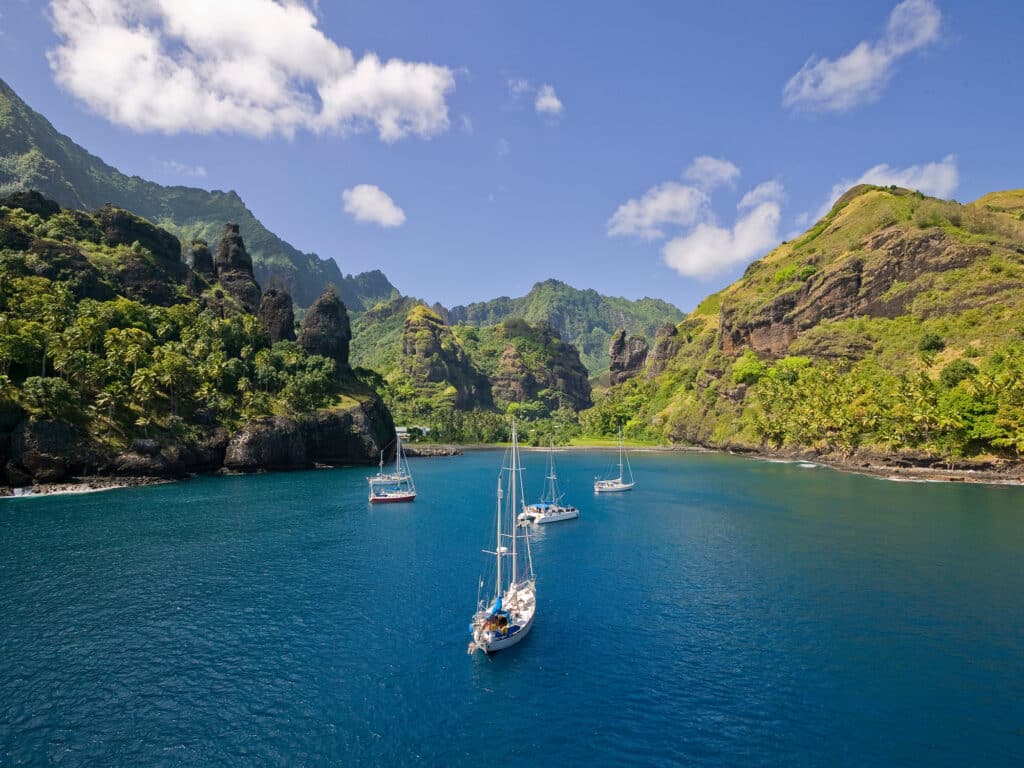 Despite their remote location, the Marquesas are a popular stopover for sailors crossing the Pacific Ocean. It’s one of the most remote island groups in the world, with the nearest major landmass being more than 1,000 miles away.
Uwe/stock.adobe.com
Despite their remote location, the Marquesas are a popular stopover for sailors crossing the Pacific Ocean. It’s one of the most remote island groups in the world, with the nearest major landmass being more than 1,000 miles away.
Uwe/stock.adobe.com
The Galapagos Islands used to be a favorite stopover en route to French Polynesia, but restrictions on visiting yachts, complex formalities and associated expenses now deter most sailors from stopping there. There was a record high of 395 in 2010, but the figure for 2022 dropped to 66.
For those who decide to bypass Galapagos while on route to French Polynesia, the logical option is to sail directly from Panama to the Marquesas. A somewhat longer but potentially more attractive alternative is a detour to Easter Island and, from there, the Pitcairn Islands to French Polynesia. Easter Island, one of the most remote sailing destinations in the world, recorded the steepest decline highlighted by this latest survey. According to the port captain of Hanga Roa, the main settlement and port, “Compared to a record of 79 yachts that called in 2015, only seven stopped here in 2022.” Most of them continued west to the Pitcairns, once the hideaway of the Bounty mutineers, whose descendants live on this remote speck of land and welcome visitors. One descendant, Brenda Christian, emailed me to say: “In 2022, we were pleased to welcome 122 yachts.”
The majority of boats bound for the South Seas, whether from Panama or North America, make their first landfall in the Marquesas. Arriving at those spectacular islands after weeks spent at sea is an awe-inspiring and unforgettable experience. Some 264 boats arrived there in 2022, the majority at Atuona on the island of Hiva Oa. Total arrivals for all of French Polynesia were 404, a significant drop from the record 826 reported in 2010.
Sailing west from Tahiti, several detours can be made from the main trunk route, such as to Suwarrow, an uninhabited atoll in the Northern Cook Islands where a caretaker is based during the peak arrivals time. Only 16 boats stopped there in 2022 compared with 69 boats in 2015. Another popular place, also in the Cook Islands, is Palmerston Atoll, which was visited by only three boats in 2022, with none in the previous year. This was also the case in neighboring Tonga, which didn’t lift its pandemic restrictions until early 2022. The northern island group of Vava’u, a longtime favorite among sailors, welcomed only 14 arrivals compared to an all-time peak 424 in the previous survey.
The above places are close enough to the main trans-Pacific route not to entail much of a detour, which may explain why only four boats called at Tuvalu. This small Polynesian community is threatened by rising sea levels from climate change.
Fiji is an important cruising hub in the South Pacific, and its capital, Suva, welcomed 83 yachts in 2022. From there, most cruising boats leave the tropics before the start of the cyclone season and sail to New Zealand or Australia. Both those countries closed their borders at the start of the pandemic, causing mayhem among sailors. The restrictions were only lifted in 2022, when 324 boats were welcomed in New Zealand and 330 in Australia. After no arrivals in 2021, New Caledonia was visited by 241 boats in 2022, a hopeful indication that the situation is gradually returning to normal.
There has also been a considerable decline in the number of visiting boats in the western North Pacific, where weather conditions are noticeably affected by ocean warming. The Philippines now endure tropical cyclones every month of the year, but continue to attract visiting boats, most of them in less-affected areas. On the Asian mainland, the expected boom in visiting cruising boats has failed to materialize, and the figures from Hong Kong show a considerable decline compared to previous surveys. The few foreign yachts that visit Hong King are participants in races organized by the Royal Hong Kong Yacht Club. There has not been much more movement in China, either, since formalities for visiting yachts continue to be complicated and expensive.
A small number of cruising boats make it as far as Japan every year, with an estimated 12 foreign yachts passing through Osaka in 2022. Most of them continued east, with some stopping at Alaska’s Dutch Harbor on their way to Canada or the US West Coast. Dutch Harbor is a busy fishing port at the eastern edge of Alaska’s Aleutian Islands, and nine yachts visited there in 2022. Provisioning and repair facilities in Dutch Harbor are excellent, making it a good base for an eastbound transit of the Northwest Passage.
Although rarely affected by tropical storms, Hawaii still sees relatively few foreign-flagged yachts. The authorities do not keep a record, and the best guess is that about 20 foreign yachts called at the islands in 2022. Hawaii does attract many mainland boats for cruising and racing. Some sail from there to French Polynesia, and a few continue west toward Micronesia and the Asian mainland. Some of them were among the 14 arrivals recorded in the Marshall Islands, which is a fair estimate of the number of boats visiting the Micronesian islands.
Indian OceanThe number of foreign-flagged boats has shown a steady decrease in the North Indian Ocean, with most boats on a world voyage sailing the Cape of Good Hope route to reach the Atlantic Ocean, rather than the Red Sea and Suez Canal alternative. By contrast, there continues to be significant coastal traffic, with more local and regional boats racing, cruising and joining the rallies and regattas during the winter season in Western Malaysia and Thailand.
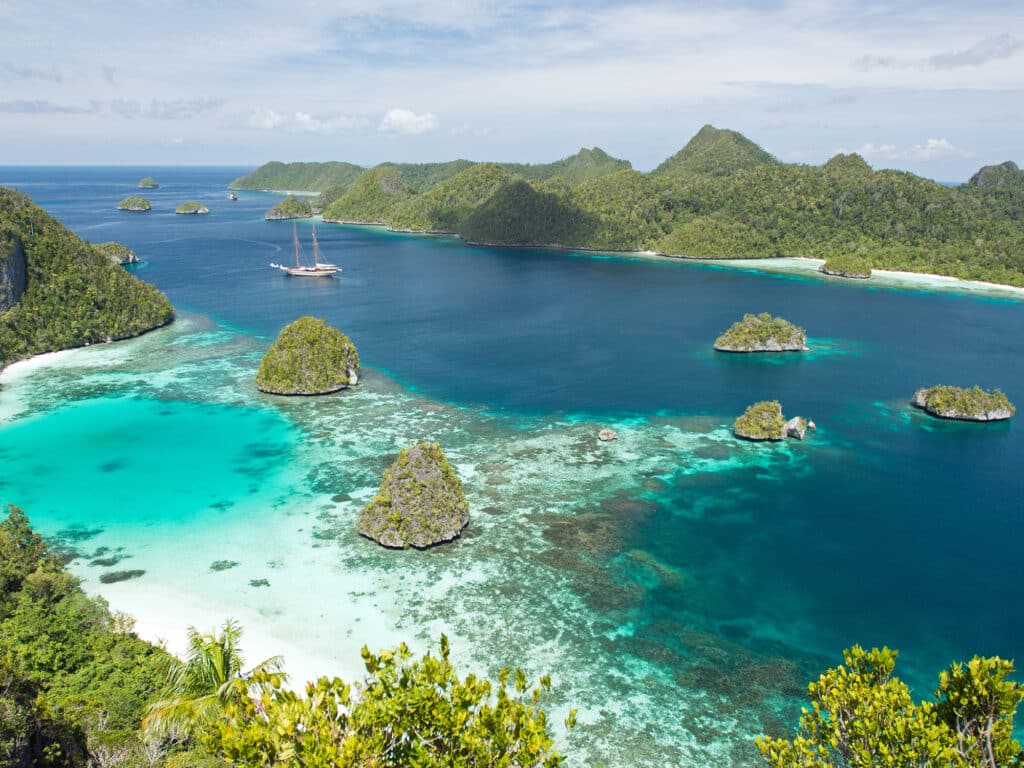 Indonesia is known for its vast and diverse archipelago, consisting of over 17,000 islands. This makes it a popular destination for cruising boats, offering a wide range of sailing opportunities from remote and uninhabited islands to bustling ports and cultural hotspots.
Anemone/stock.adobe.com
Indonesia is known for its vast and diverse archipelago, consisting of over 17,000 islands. This makes it a popular destination for cruising boats, offering a wide range of sailing opportunities from remote and uninhabited islands to bustling ports and cultural hotspots.
Anemone/stock.adobe.com
For sailors undeterred by the Red Sea who continue west across the North Indian Ocean, a convenient port is Galle, on the south coast of Sri Lanka, where 23 arrivals were recorded in 2022. Some further detoured to Cochin in southern India, which welcomed 11 boats last year. Djibouti continues to be the only safe haven to prepare for the arduous transit of the Red Sea, and 29 boats stopped here before heading north. All of them made it safely to Suez, Egypt, which recorded 36 arrivals in 2022 compared to 2010, when 171 yachts transited the Suez Canal.
Approximately 250 yachts transit the Torres Strait between Australia and New Guinea every year, and half of them continue west into the South Indian Ocean. The others explore the Indonesian archipelago, where formalities have eased in an attempt to attract more visitors. Even so, in 2022, only 46 foreign vessels obtained the required cruising permit issued by the Indonesian Ministry of Foreign Affairs, compared to 236 in 2016.
Significantly fewer boats stopped at Darwin in Northern Australia, which saw 23 arrivals in 2022 compared to 72 in the previous survey. The Australian outpost of Cocos/Keeling, a popular stop on the world sailing circuit, was also affected by the pandemic, with only 31 arrivals in 2022 compared to 99 in 2015. From Cocos/Keeling, the westbound route splits into a southern branch to Rodrigues in Mauritius, and a northern branch bound for Chagos in the British Indian Ocean Territory. The latter recorded six visitors, a significant drop from the 23 boats six years earlier, as the British authorities now limit permits to those who can justify the need for a stop. The most popular stop along the southern route is Port Louis in Mauritius, with 242 arrivals recorded in 2022, a definite proof of the predominance of the Cape of Good Hope route among boats on a world voyage.
When discovered as a cruising destination, Madagascar was expected to become the major cruising attraction in the South Indian Ocean, but the lack of facilities and cumbersome bureaucracy dashed those hopes. Nosy Be, an island on Madagascar’s northwest coast, has established itself as a modest base, but few world voyagers bother to make the lengthy detour from Mauritius or La Reunion. Only eight visiting boats were recorded in the Nosy Be area in 2022.
On the eve of the cyclone season, all boats make their way south. In 2022, Richards Bay was the favorite South African landfall, with a total of 103 arrivals. The number of boats that called at Cape Town was 126, of which 123 were bound for the South Atlantic and three for the Indian Ocean. Thanks to the Ocean Sailing Association of Southern Africa, this was one of the few countries that didn’t close its borders to visiting sailboats during the pandemic.
Sailing HubsIn addition to highlighting the drastic reduction in the number of cruising boats on world voyages, I noted three other trends: the small size of crew on long voyages, with many couples sailing on their own; the number of couples with young children setting off on a shorter or longer sabbatical leave; and the steadily increasing proportion of catamarans among cruising yachts.
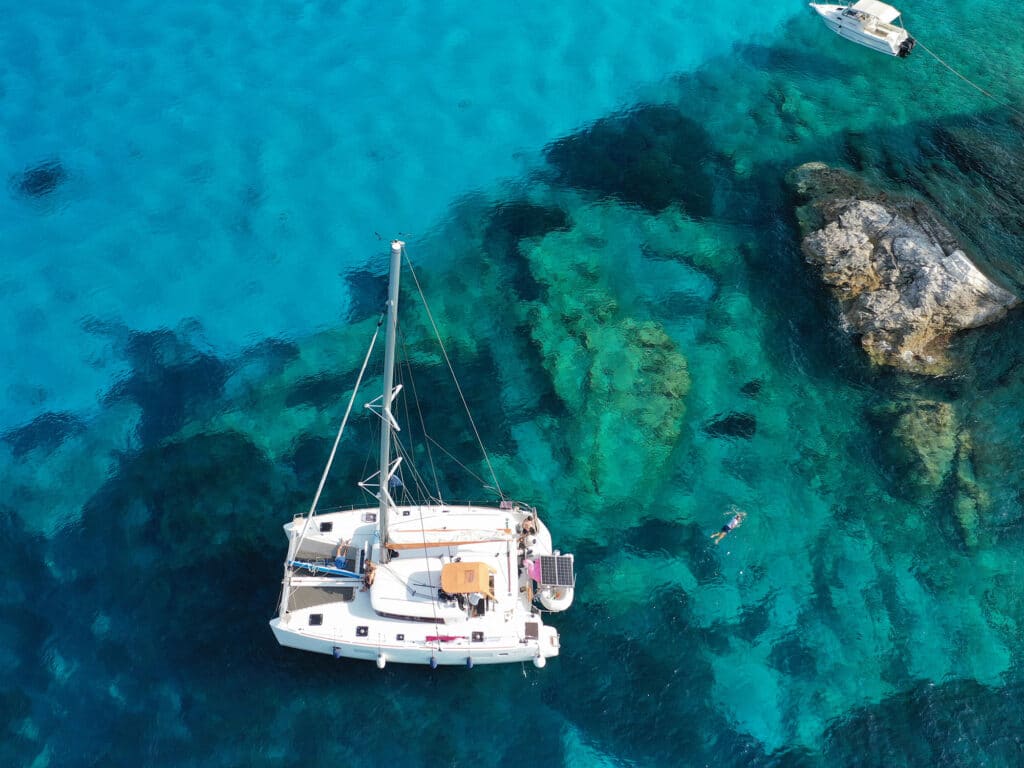 Cruising catamarans have been experiencing a significant increase in popularity within the long-range cruising community.
aerial-drone/stock.adobe.com
Cruising catamarans have been experiencing a significant increase in popularity within the long-range cruising community.
aerial-drone/stock.adobe.com
These trends may be related, so I widened the scope of this survey to find out more about the type of boats undertaking long voyages, such average length, crew size, whether they were monohulls or catamarans, as well as the predominant nationalities on board.
Figures obtained from Panama and Las Palmas de Gran Canaria made it possible to calculate the average length of the boats. To arrive at a realistic figure, only boats under 60 feet were included. The average length of monohulls in Las Palmas was 12.97 meters (42.6 feet), and multihulls were 13.80 meters (45.2 feet). In Panama, the average for monohulls was 15.20 meters (49.8 feet), and for multihulls it was 15 meters (49.1 feet). The average length of boats over 60 feet (18 meters) in Panama was 34 meters (111 feet).
In Las Palmas, multihulls made up 10.1 percent of the total number of boats, whereas in Panama it was 17.2 percent. The proportion of multihulls was even higher during the ARC 2022 from Las Palmas from Gran Canaria to St. Lucia. Among the 140 boats that sailed this classic route, more than a quarter (36) were multihulls, with 33 catamarans and three trimarans, equivalent to 25.7 percent. The average length for monohulls was 15.7 meters (51.4 feet) and 14.1 meters (46.3 feet) for multihulls. The size of boats taking part in the ARC has been steadily increasing over the years, and in this latest edition, 31 monohulls were bigger than 50 feet, with 22 multihulls more than 60 feet long.
More-efficient and better-equipped boats with reliable autopilots, electric winches, furling gears and other accessories have resulted in fewer crew. This was evident from the crews of the boats that called at Cape Town, having an average of 2.9 crew, while in Saint Helena it was 3.2. In Cocos/Keeling it was 2.5, and in Tahiti, the figure was 2.8. In the latter two cases, more than half the boats were crewed by just a couple.
Another interesting trend is the change in the predominant flags of the boats on a world voyage. Statistics obtained from Gran Canaria, the Azores, Tahiti, Cape Town, Saint Helena and the Suez Canal show that US-flagged yachts have lost the top spot to French-flagged boats, with British and German boats competing for third place.
ConclusionsSince my first global survey in 1987, the cruising scene has seen important changes. This survey found that in a few places, there has been an increase in the number of visiting yachts, but overall, the figures from Las Palmas, Bermuda, Panama, Tahiti, Cape Town, New Zealand and Australia indicate that the popularity of long-distance voyages peaked in 2010.
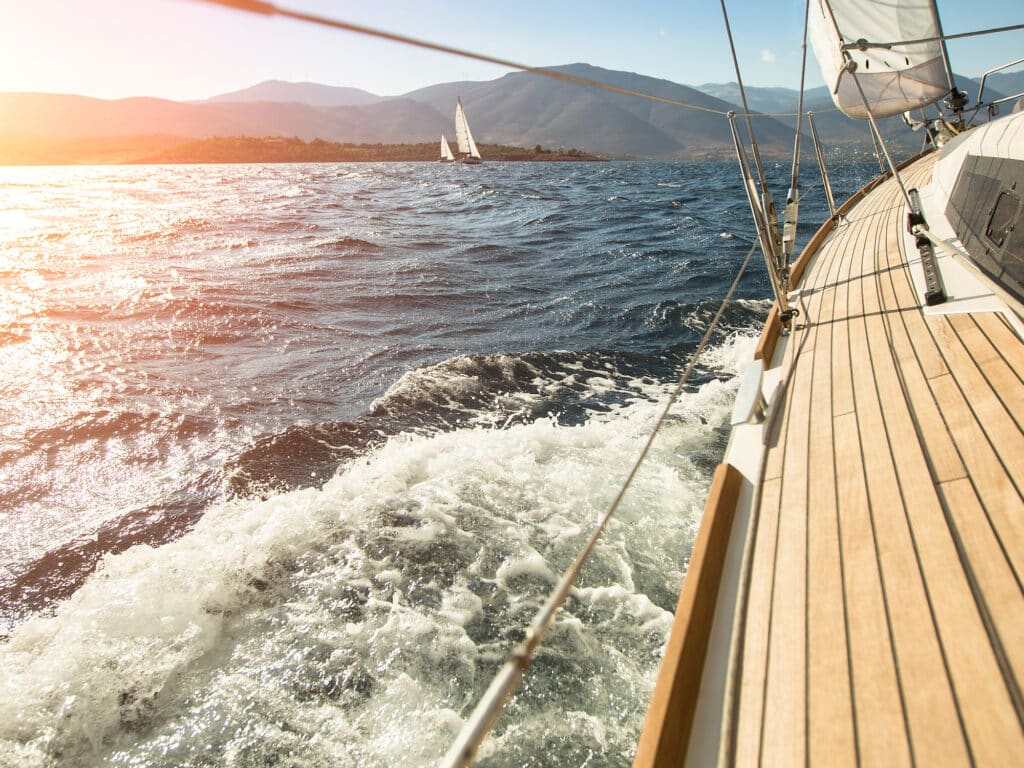 In some of the most popular cruising destinations, there has been a steady reduction in the number of boats undertaking world voyages.
De Visu/stock.adobe.com
In some of the most popular cruising destinations, there has been a steady reduction in the number of boats undertaking world voyages.
De Visu/stock.adobe.com
The reasons all seem related to safety concerns. Climate change, for instance, is affecting offshore weather conditions. In my latest survey among 65 experienced sailors, I asked how they would plan a world voyage today. Without exception, each one stressed that they would take changing weather into account, but would still leave on a long voyage. They all agreed that proper voyage planning was now even more important, and they were confident that a safe voyage could still be accomplished.
This global survey also confirmed that since 2010 in some of the most popular cruising destinations, there has been a steady reduction in the number of boats undertaking world voyages. The pandemic had a significant negative impact, so it will be interesting to see whether that changes. After all, boatbuilders are reporting full order books with waiting times as long as three years, and the brokerage market is enjoying an unprecedented boom. Carpe diem!
Described as the bible of cruising sailors, Jimmy Cornell’s book World Cruising Routes is the definitive reference book for long-distance navigators. The latest completely revised and updated edition has drawn on the latest weather information and other recent developments to provide the most comprehensive aid to planning a safe voyage to any part of the world. Get it HERE.
Visit cornellsailing.com for information on Cornell’s Ocean Atlas and Jimmy Cornell.
The post Global Movement of Cruising Boats appeared first on Cruising World.
- Home
- About Us
- Write For Us / Submit Content
- Advertising And Affiliates
- Feeds And Syndication
- Contact Us
- Login
- Privacy
All Rights Reserved. Copyright , Central Coast Communications, Inc.